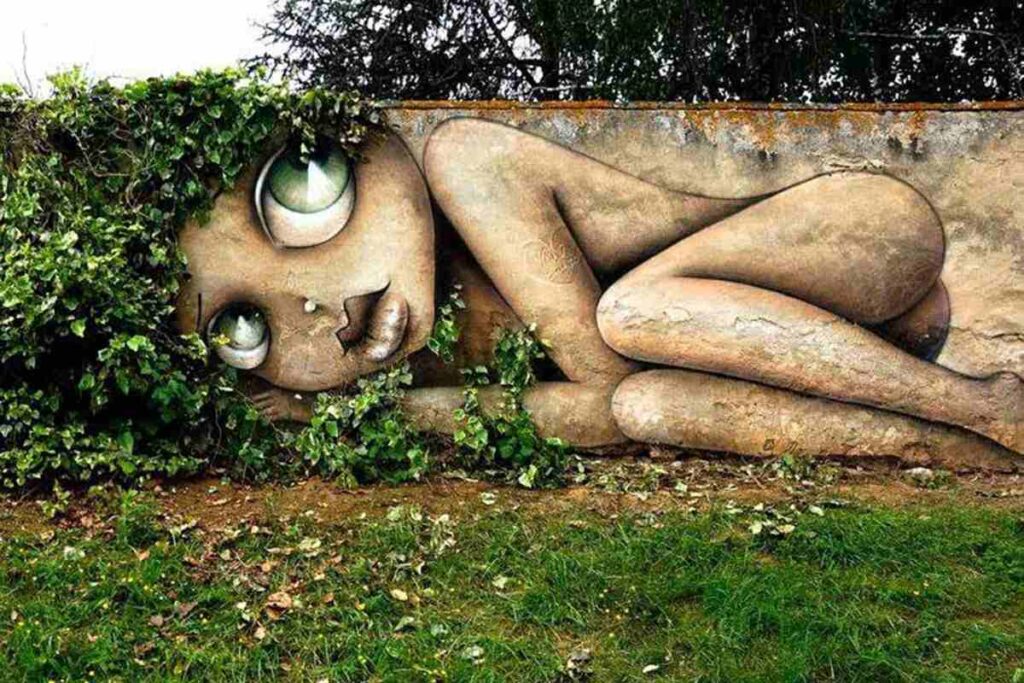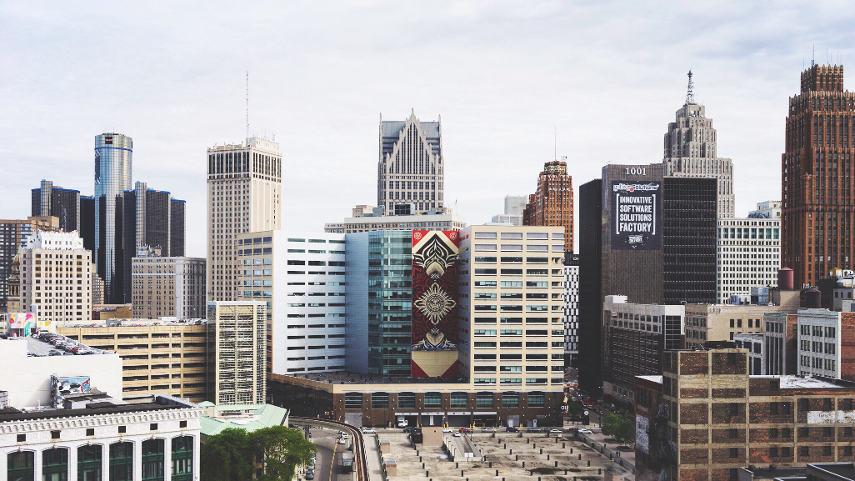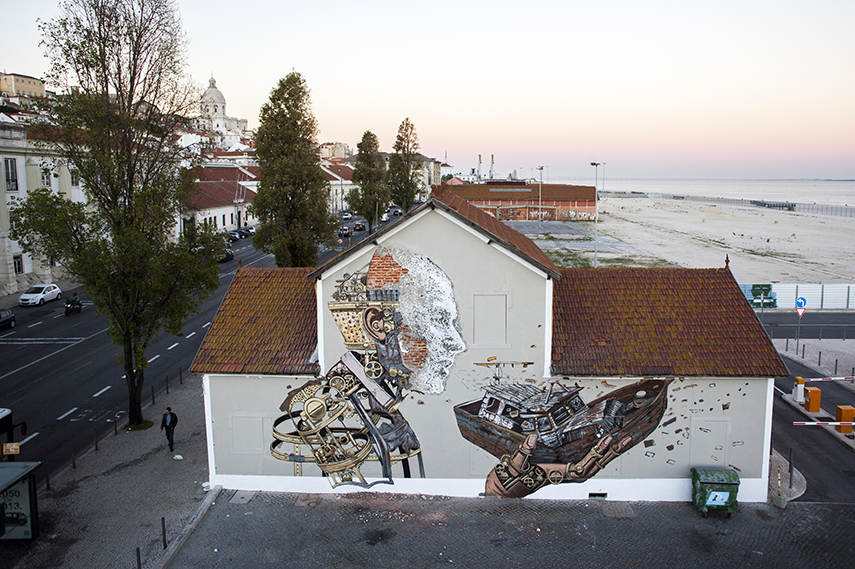How to Paint a Mural – Complete Guide for Wall Painting
When you take a look at the career path of many established street artists working today you cannot help but notice that mural painting is one of the capital parts in their body of work. There is a point in the career of every street artist when he wants to take his artistry on the next level, and you can’t go bigger than trying your chances in the field of mural painting. For those emerging talents who aspire to enter the scene of street muralists, there are some serious things to consider regarding the mural painting techniques, tools, choice of the materials and the location. Let’s face it, mural painting is time-consuming and expensive work especially in large-scale projects. It is rarely done against the law and often requires permission, sometimes not so easily obtained.
But if you are a young artist, eager to do his first mural painting, you won’t let technical issues like these to get in your way. If there is a will there is a way and if you want to learn how to paint a mural maybe we can help you by introducing some essential tips you should keep in mind before you hit the streets packed only with your talent, good will, and ambition. In the next paragraphs, we are bringing the mastery of mural painting to you step-by-step, in a short preview of the main techniques, tools, materials, supplies and everything else you should know for your first mural project.
How to Paint a Mural Tips – Choose the Right Wall
There is no one specific or right tip on how to paint a mural, but some parts of the equation are essential. As mentioned earlier the right wall and good location for a mural are not easy to find. You can’t just spray some paint and run if required because you will be working on your masterpiece longer than you expect. In many cases, you will need permission for painting a mural from the owner of the building of the city officials, especially if you plan a large project in the public space area. You also want to make your piece visible to the public, because you don’t want to waste your precious time in making the monumental artwork that nobody is able to see. But the visibility opens up a question of the right neighborhood and there are always those local communities that are intolerable towards arts on their streets. Perhaps, one of the best ways to do your first mural is through participation in some of the festivals, as they are usually supported by the officials and the location for painting a mural is iven to you on a plate. All you’ll need are your good skills, great ideas and mural design that you like, and of course materials.
Use Grid – The Easiest Way to Transfer Ideas on the Wall
When it comes to different ways of how to paint a mural or a wall picture, one of the easiest ways to transfer your design onto the large wall surface is by using a grid. Whether you are painting the wall or doing murals in stencil technique it comes really handy to split your sketch into smaller parts and do your work one step at the time. You don’t want to lose yourselves in a big picture. It takes more time to be sure, but better safe than sorry because when it comes to the large-scale projects the use of grid is the best way to ensure the perfection of your piece. You should leave your freehand painting for some other occasion or even proceed if you feel really confident about the level of your skillfulness. However, if you decide to go with the grid method, the first thing you need to do is to split your sketch into the grid squares in proportion to the wall and planned surface of your future mural. Then you should replicate the squares from your referential drawing into corresponding squares on the wall surface. After your picture is set you can erase the lines and you’re ready to paint and bring some color into your design. Another useful method for really large projects is the use of a professional projector, which can be costly, so you might skip this option for a while and consider acquiring a projector once again when you are well known and preferably well-off.
Next Step – Mural Techniques and Materials
And now let’s talk mural materials. If you are not Vhils and you do not share the same aspirations then you will be using paint in great amounts. But what paint should you use? You want your mural to be astonishing and not washed away on the first rainy day or transferred into a shadow of the original artwork once the sunlight has had its way with it. Well, there are several options when it comes to the paint you need. Unless you paint on the wall of your home, or home of your friend you will use resistant color paints. Most of the murals today are made in the oil-based or acrylic paint because these give long-lasting color effects when painting in the outdoor areas.

THE ULTIMATE GUIDE TO COLOUR SELECTION FOR YOUR INTERIOR
The colour palette is one of the most important design decisions you’ll need to make when decorating a home. From paint colour to fabrics and finishes, colour can have a large effect on how your home looks and feels.
This guide helps you understand the basics of colour, how it will affect your interior and some tips to choosing the right colour palette for your space. We’ll also share the top mistakes people make when choosing paint colours so you can avoid them at all cost.
TERMS TO GET FAMILIAR WITH
When choosing colours for your interior, there are a few terms that you may want to get familiar with.
These will help you while you research colours and speak to paint professionals:
PRIMARY COLOUR
Red, blue and yellow. Primary colours can’t be made by mixing colours together.
SECONDARY COLOUR
Green, orange and purple. Secondary colours can be made by mixing primary colours.
TERTIARY COLOUR
Six shades that can be made by mixing primary and secondary colours together. You can then add black, grey or white to change the tone, tint or shade.
TONE
Refers to the brightness or deepness of a colour. Mixing grey to the colour will affect its tone.
TINT
Refers to a shade of colour. Adding white to a colour will change the tint.
SHADE
Refers to the lightness or darkness of a colour. The term is also used when referring to similar colours such as ‘shades of green’ or a ‘darker shade of blue’. Mixing black to a colour will alter the shade.
TYPES
There are several types of colour wheels from a simple version which only shows primary colours and the basic colours such as green, orange and purple, to the more complex with a boundless number of tints and shades.

HOW TO USE PAINT
Usage
This paint is ideal for use on walls, ceilings and trim. It applies easily to properly prepared and primed plaster, wallboard, wood, brick, masonry and metal.
Prep
Thoroughly clean the surface and allow to dry. Remove wallpaper and loose, peeling paint. Remove gloss from shiny surfaces. Patch cracks and spot prime. paint can be used to prime patched areas and bare surfaces before applying the finish coat. For best results on heavily stained areas, drastic color changes or deep, vivid colors, prime
Application
Stir paint thoroughly. Intermix containers to ensure uniform color. Apply with a premium-quality roller, polyester brush or airless sprayer. Paint the ceiling first, then the walls. If applying by roller, roll from dry area into wet area using firm, crisscross strokes. Finish with long, even strokes in one direction. Note: Some deep or bright colors may require an additional coat to obtain complete hide. Surface conditions and application technique can also impact coverage.

Things Nobody Tells You About Painting the Exterior of Your House
The best time to paint the exterior? Depends.
You’ve likely heard that the best time to paint your house is when the weather warms up—and that’s largely true. Optimal weather for paint is generally when temperatures are consistently warm and above 50 degrees F. While springtime in certain parts of the country may be warm enough, in many other parts, it’s not reliably temperate, especially come nighttime when temperatures may dip into freezing territory. Also keep in mind rainy season—which arrives for most areas in the spring.
You should leave it to professionals
Thanks to easy-to-follow YouTube tutorials, DIY culture is thriving these days. Go ahead and put up that wall shelf, swap out your faucet, and paint the walls yourself—you’ll likely save a lot of money going the DIY route—but when it comes to painting the outside of your house, it’s best to hire pros. That’s because they can often get the best deals on paint (a cost savings), already have all the equipment required, and, well, they’re pros. Painting your house, especially if it’s a multistory house, is exacting, physically demanding, and sometimes dangerous work.
Especially if there’s lead involved.
Homes built before 1978 may have paint with lead in it. That’s a whole can of worms you do not want to open without professional help
Go dark—and save money!
A perk of going dark: You may be able to skip the primer if the original paint is a lighter color, and you may need fewer coats! Another cost-saving idea: Refresh your house with the same color rather than choosing a different hue; you’ll probably need just one coat. For some cons of dark paints,
You’ll need to protect your plants
Got plants growing close to your house? You’ll want to protect them from paint drips with a drop cloth or plastic sheeting. Plants that touch the exterior of your building will either need to be removed, trimmed, or tied back so that painters have room to do their job.

THE BEST PAINT COLORS FOR A RETAIL STORE
Did you know that a room’s color can affect your mood? Studies show that color plays an important role in both our decision-making and emotional responses in everyday life. The type of products you offer your customers might influence the colors you paint your retail store, but it’s important to also consider the effect that colors have on your customers’ emotions and on their buying potential.
RED
Reds tend to increase the heart rate and create a sense of urgency. Many outlet malls and clearance shops use reds to attract customers to sale items.
ORANGE
Orange is a good color for calling shoppers to action. Though it is sometimes seen as an aggressive color, it’s more often considered vibrant and energetic.
YELLOW
Yellows are good for grabbing the attention of potential shoppers. People associate the color yellow with optimism and youthfulness.
GREEN
Green is most associated with money and wealth. When it comes to shopping, it can signify a good deal and can attract shoppers to areas they might not be drawn to otherwise. It is also the easiest color for the eye to process.
BLUE
Blues evoke a sense of trust and security, and are used most frequently by places like banks and large department stores.
PINK
Pinks are feminine and romantic, and are great for shops that sell things like perfume and lingerie. They can draw women in and make them feel comfortable while they shop.
PURPLE
Light purples are known to be soothing and calming, and are a popular choice for stores that sell beauty products.
BLACK
Most people associate black with power and luxury. It is bold and strong, and works well for attracting shoppers to stores selling expensive or high-end products.
WHITE
Whites signify new beginnings and are most often used in bridal shops and infant clothing & necessity stores. People associate whites with cleanliness and freshness.
Tips for Painting a Retail Store
Pastels are great for children’s stores, as home nurseries are commonly painted these colors.
If you have a logo, incorporate its colors into your store.
Limit bright colors like yellows, oranges and reds to accent walls to avoid overwhelming or pushing away customers.
For larger stores, paint the ceiling a darker color to promote a more intimate and friendly feeling.
Make sure your wall colors don’t clash with the colors of the items you sell (or their packaging).